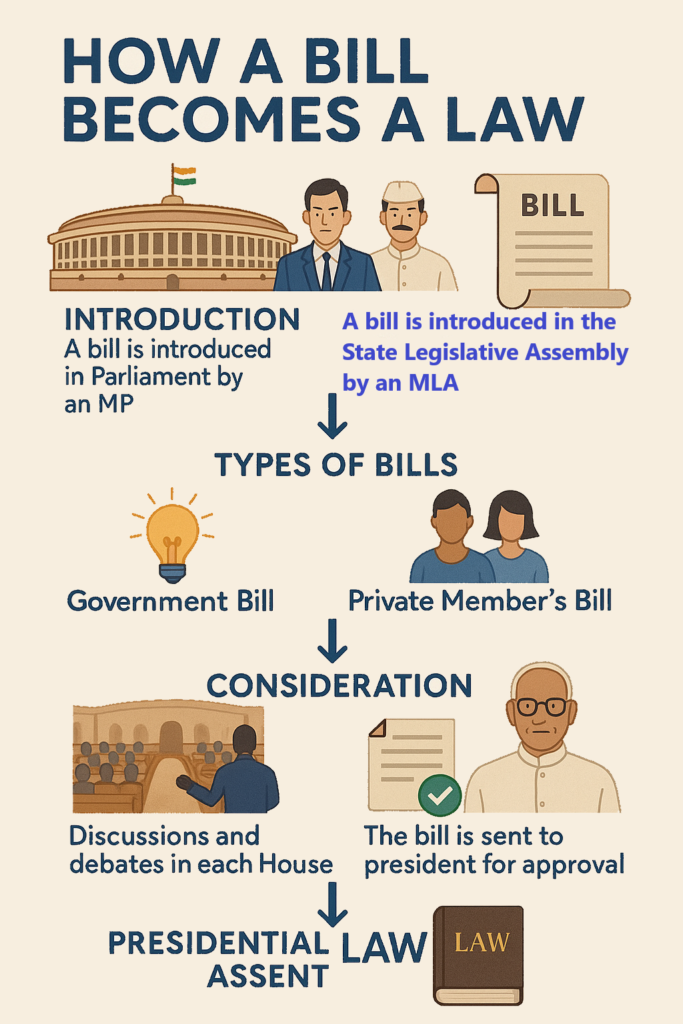How a Bill Becomes a Law in India – Explanation
In a democracy like India, laws are created to guide the behavior of citizens and maintain order. Bills are proposals for new laws or changes to existing laws, and the process of turning a bill into a law involves multiple steps. Let’s break it down in an easy-to-understand way, step by step.

Step 1: Introduction of the Bill
A bill can be introduced in either House of Parliament (the Lok Sabha or Rajya Sabha) by a Member of Parliament (MP) or a Member of the Legislative Assembly (MLA). It is first introduced as a proposal to make a new law or amend an existing one. The Government of India usually introduces most bills, but MPs or MLAs can also propose bills.
There are two main types of bills:
- Government Bills: Proposed by the ruling party or government ministers.
- Private Members’ Bills: Proposed by MPs or MLAs who are not part of the government.
The bill is then read out, and the title and subject are discussed. It is then presented in Parliament, where the first reading takes place.
Step 2: First Reading – Introduction
The first reading is mainly formal and involves the bill’s title, purpose, and key points being introduced in the Parliament. During this stage:
- The bill’s full text is distributed to all members.
- There is no debate or voting at this stage.
- The bill is simply introduced and formally recorded.
After this, the bill is referred to a parliamentary committee for detailed examination, or it may be debated on in the next stages.
Step 3: Second Reading – Detailed Examination
The second reading is where the real discussion begins. During this stage:
- Members of Parliament or the Rajya Sabha discuss the principles and objectives of the bill.
- The bill’s merits and potential impact are debated.
- If there are any concerns or suggested changes to the bill, they are discussed.
At the end of the second reading, voting takes place. If the majority of MPs agree, the bill moves on to the next stage. If not, the bill may be rejected.
Step 4: Committee Stage – Detailed Scrutiny
If the bill passes the second reading, it goes to the committee stage. In this stage:
- A special committee of MPs or Rajya Sabha members is formed to examine the bill in detail.
- The committee might hold discussions, ask for experts’ opinions, and suggest changes (called amendments) to the bill.
- The committee will report back to Parliament with any changes they recommend.
Step 5: Report Stage – Further Examination
The committee report is presented to Parliament during the report stage. Here:
- The members go over the committee’s recommendations.
- Debates are held on any suggested changes.
- MPs have the option to accept or reject the committee’s amendments.
After this, the bill proceeds to the third reading.
Step 6: Third Reading – Final Approval
The third reading is the final discussion stage:
- MPs or Rajya Sabha members debate the final version of the bill.
- They can only discuss what has already been approved in the earlier stages (including amendments).
- There is a final vote on the bill.
If the bill is approved, it moves to the other House of Parliament. The process will repeat in the second House (if the bill started in the Lok Sabha, it goes to the Rajya Sabha, and vice versa).
Step 7: Consideration by the Other House
The bill now moves to the other house of Parliament (either the Rajya Sabha or Lok Sabha) for consideration:
- The bill goes through the same stages in the other House: the first reading, second reading, committee stage, and third reading.
- If the second House makes changes to the bill, it is sent back to the first House for review.
- If both Houses agree on the final version of the bill, it proceeds to the President of India.
Step 8: Presidential Assent – Final Approval
Once both Houses of Parliament approve the bill, it is sent to the President of India for approval:
- The President can either approve the bill and turn it into law or reject it (called a veto).
- In most cases, the President approves the bill.
- If the President gives their assent, the bill officially becomes a law and is called an Act of Parliament.
Step 9: The Bill Becomes a Law
After the President’s assent, the bill is officially a law and can be enforced. The new law may have a specific date when it comes into effect, or it may become effective immediately.
Types of Bills
In India, bills can be classified into different types based on their content and purpose:
- Money Bills: These deal with taxes, government spending, and loans. A Money Bill can only be introduced in the Lok Sabha and needs to be passed by both Houses of Parliament.
- Ordinary Bills: These cover all other areas, such as health, education, or law. They can be introduced in either house.
- Constitutional Amendment Bills: These bills are introduced to make changes to the Constitution. They require a special procedure to pass.
Summary:
The process of how a bill becomes a law in India involves several important stages. A bill is first introduced in Parliament, where it undergoes discussions, committee reviews, and debates in both Houses of Parliament. If both Houses agree on the bill, it is sent to the President for approval. Once the President gives their assent, the bill officially becomes a law. This process ensures that laws are thoroughly examined, debated, and approved by elected representatives before they impact the public.
Tags: bicameral legislature, bill amendments, bill approval, bill discussion, bill examination, bill introduction, bill introduction by government, bill passage, bill processing in Parliament, bill reading stages, bill rejection, bill to law process, bill voting, committee stage, constitutional amendment bills, constitutional amendments, final law approval., first reading, government bills, government legislation, Indian Constitution, Indian democracy, Indian Parliament, Indian Politics, law enactment, law enforcement, law formation India, law making process, law making steps, law proposal, legislative approval, legislative checks and balances, legislative committee report, Legislative Process, legislative process India, legislative scrutiny, legislative stages, Lok Sabha, Member of Legislative Assembly (MLA), Member of Parliament (MP), money bills, ordinary bills, parliament procedure, parliamentary committee, parliamentary debate, Parliamentary System, parliamentary voting process, President of India, presidential assent, presidential veto, private member bills in India, private members’ bills, Rajya Sabha, report stage, second reading, third reading, types of bills


